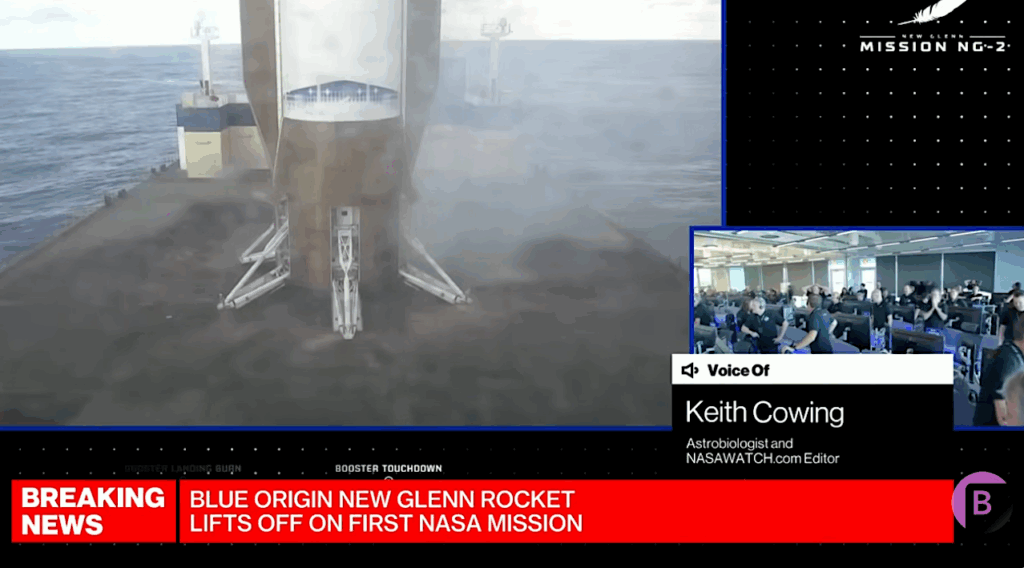Blue Origin Announces First Customer and Releases New Glenn Video

Blue Origin Announces First Customer for New Glenn Launcher, SpaceRef
“Jeff Bezos has a customer for his New Glenn launch vehicle, Eutelsat, which he announced at Satellite 2017 this morning in Washington, DC. While still years away from operations, Blue Origin has been making steady progress in a step-by-step fashion. It is this stead process ‘in the right sequence’ that Jeff Bezos views as being most important to his company’s success.”
 Marc’s note: At Satellite 2017 this morning Jeff Bezos unveiled a new video introducing the New Glenn rocket which follows in SpaceX’s footsteps in returning the first stage for future reuse. Keith is at Satellite 2017 and you can follow his tweets @NASAWatch.
Marc’s note: At Satellite 2017 this morning Jeff Bezos unveiled a new video introducing the New Glenn rocket which follows in SpaceX’s footsteps in returning the first stage for future reuse. Keith is at Satellite 2017 and you can follow his tweets @NASAWatch.









Unsurprisingly similar to Falcon-9 and I’m not accusing Blue Origin of being copycats either. I suspect that what we’re seeing here is that commercially-oriented designs for Delta-II- or even Atlas-V-class launch vehicles are heading in the same general direction: Two-stage with core propulsive return. This is the direction in which teams who want to design commercially-viable launch vehicles are all going.
I suspect that we’ll see more Falcon-9-class LVs appearing, even from some state launch services like India, China or Russia who have less money to throw around. Eventually, the pressure on ULA to provide a similar product will start growing and yes, I think that even NASA will feel a little of the heat too.
Looks like 7 engines rather than 9, and a ‘O’ rather than a ‘X’ 😉
VTVL designs do tend to look similar.
Just imagine them trying to land 9 first stages at the same time, SpaceX and Blue Origin can play Tic Tac Toe with the drone ships.
The Falcon 9 Block 5, the Falcon Heavy & the New Glenn Lite are all much more capable then a mere EELV Class launch vehicle.
The time is short for someone to developed a launch vehicle similar to the SpaceX & Blue products. There wilt not be room for other players in the commercial field once the New Glenn enters service.
The Delta II or light medium class is going away IMO. The forthcoming payloads will either be too heavy or too light to justified using this class of launch vehicles.
Yup. These reusable heavies: New Glenn/Armstrong, FH and ITS scream launching BEO, crews, large orbital, and large constellation bulk launches. Expendable, smaller launchers beware.
This is great news. More competition is a good thing.
Ben R-G’s point highlights part of the reason X-33/Venturestar went wrong. A number of folks back then knew that SSTO was too big a hurdle and that two-stage reusability was the more appropriate target for ‘the next step’ beyond the first foray (1 1/2 stages) into reusability taken by STS.
We are witnessing ‘the next step’. One can’t help but wonder where we might be today if this cautious (but technically informed) wisdom had prevailed over the wishful SSTO dreams back in the 1990s.
To be fair X-33 kind of started off as a follow-on to DC-X, which was a VTVL demonstrator. But then NASA solicited bids for X-33 and somehow a VTHL vehicle was picked as the winner. It was arguably far more complex than its competing VTVL competition, which would have built on top of the success of DC-X.
Surprise, the far more complex “winning” X-33 vehicle turned into a failure.
FWIW, something like DC-X mounted on top of a Falcon-9-type reusable booster has been my favoured fully-reusable orbital design for a while
Wasn’t X-33 abandoned when LM couldn’t solve the delaminating composite fuel tank?
Which, again, was an artifact of a push for SSTO; vertical versus horizontal flight was a secondary (and I would hold relatively minor) argument without an issue. Without that hyper-light fuel tank (and some of the other beyond-cutting-edge technologies) SSTO didn’t have a prayer of feasibility…if it ever has one at all in 1-G. Granted, the primary point of the program (and this includes DC-X) was to push said technologies, but once NASA’s sales machine got hold of it, the entire effort was a set-up for a grandiose fall whose ground-hitting thump caused detrimental programmatic reverberations that we’re still feeling today.
I also remember some at NASA calling it FrankenStar when they started altering the original design. I remember CG pics of the payload external of the vehicle when they realized they needed more fuel.
The X-33 was a suborbital test vehicle. It was considered a precursor for a (still conceptual) SSTO design. The delamination problem itself was primarily a matter of choosing the optimal composite materials. Composite LH2 tanks, in a simple cylindrical form, were actually built and demonstrated at the time to be durable and reusable.
However the contractor determined that metal LH2 tanks would actually be lighter than the proposed composite tank because of the complex shape required to make the tank conform to the X-33’s lifting body structural envelope.
The NASA manager rejected the use of metal LH2 tanks because he believed conformal composite LH2 tanks would be needed for SSTO, and that the X-33 only had value if it led directly to an SSTO launch vehicle. If this weren’t possible, he felt the program should be cancelled, and ultimately did so.
Some observers at the time felt that the X-33 could provide useful results as a prototype and technology demonstrator even if it demonstrated that SSTO was not feasible with the available technology. Others felt the program had become too expensive and complex, and that the “linear aerospike” engine, the heart of the concept, was too heavy to be competitive with conventional bell nozzle designs.
Interesting to note that the video is a satellite launch and not a human flight. That says volumes about the fact that they need to chase the only money making aspect of space flight to date.
Manned flight is a part of their program. Blue took NASA funding for their biconic capsule. They also plan on suborbital human flights. That they are at a SATELLITE forum releasing a video about launching SATELLITES does speak volumns .. called playing to your customers.
Slick CG is easy (as NASA has found out). So far SpaceX is the only one that has matched their digital brochures with real world hardware.
Not really. SpaceX just unloaded a bunch of silly CGI stuff last September, with things flying around Saturn and landing on icy moons.
But BO flights to CGI rate is trending towards lame as well, New Shepard was supposed to be doing regular flights all of last year, what happened ?
Space-X’s CGI is way better than Blue Origin’s CGI.
SpaceX’s first stage landing CGI is far more realistic.
Remind me where the real world hardware for this one is:
https://www.google.com/url?…
https://uploads.disquscdn.c…
https://uploads.disquscdn.c…
Well looks like real hardware is being tested, to me not just CGI.
https://www.google.com/amp/…
http://spacenews.com/blue-o…
Looks like their are even?
Even maybe as far as methalox engine development goes (although I believe the Space-X Raptor is a more ambitious engine than the BE4) however I would say Space-X are a far ahead of Blue in most other respects although who knows what the next few years may bring.
I’m suspicious of that tank photo. Only one person and it is clean like a Hollywood movie scene (I’ve seen one other, it has few more people but I’m thinking there’s gotta be a lot of messy debris someplace). Where’s a place with lots of people, lots of parts and tools? Or is much of that automated or outsourced where these nice buildings are simply final assembly like the VAB?
No Idea where the COPV photo was taken but suffice to say it’s a publicity photo and set up to look as spectacular as possible and not necessarily indicative of how or where it was manufactured, it would be very interesting to see how it’s made but I guess that is something Space-X would not be so keen on showing as they tend to rely on proprietary information rather than patents.
what launch site are they planning on? KSC or the air force side? so far everything from Blue Origin has been in west Texas right? would that mean the barge landing is in the Gulf of Mexico?
Blue is converting the old CCAFS LC-36 pad for launching the New Glenn.
That is not a barge in the video. Look more like a converted VLCC or bulk carrier. IIRC the Oceanic recovery location for the New Glenn core is off the coast of the Carolinas from NSF forum chatter. So it appears that the core is too energetic for recovery near the launch area.
FYI the US government will never let anyone launch a large orbital rocket from West Texas. Since said rocket will have to overfly populated areas and energy install ions (refineries, oil fields, etc.)..
thanks for the info. I didn’t expect it to launch from West Texas due to overflight like you said but hadn’t heard anything about where they planned long term operational flights from.
Shouldn’t that drone ship have a big ‘X’ on it, just to help them land on the spot?
I think they have decided on a big “O” instead.